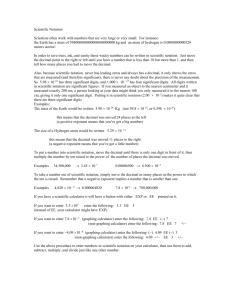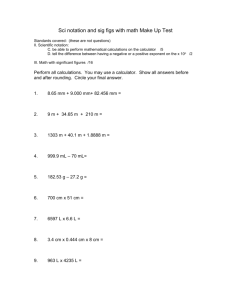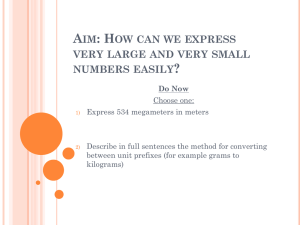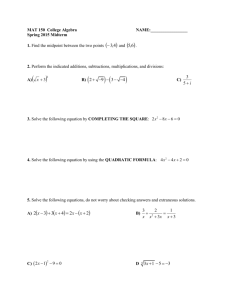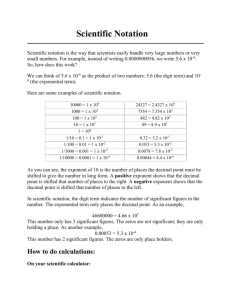Lesson Notes
advertisement
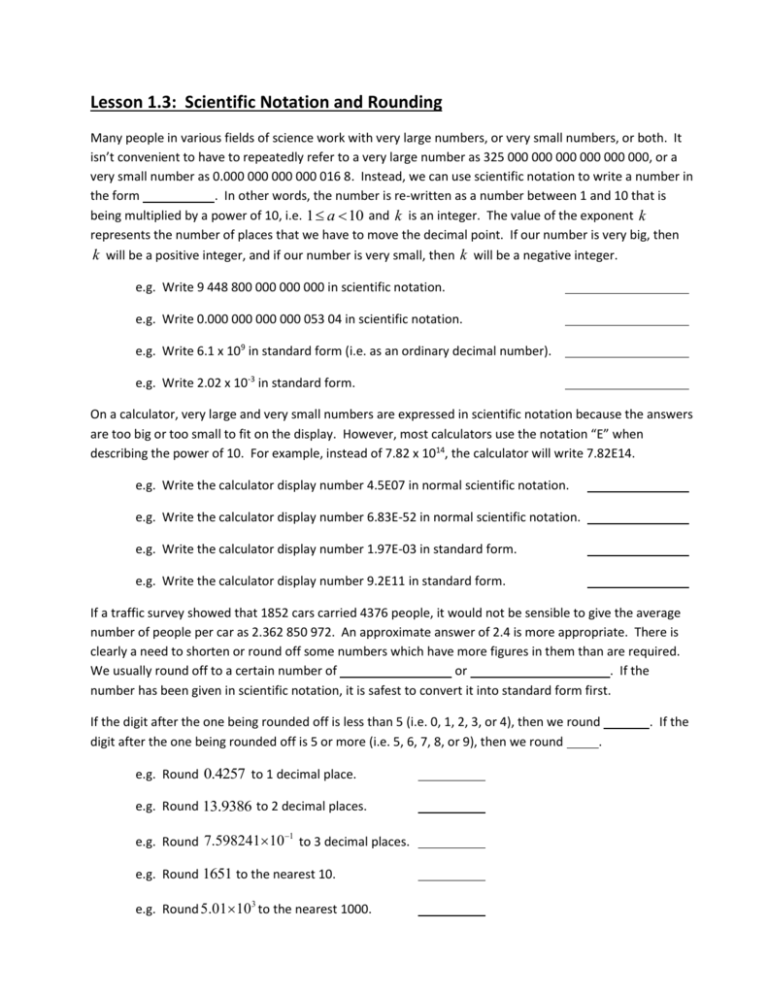
Lesson 1.3: Scientific Notation and Rounding Many people in various fields of science work with very large numbers, or very small numbers, or both. It isn’t convenient to have to repeatedly refer to a very large number as 325 000 000 000 000 000 000, or a very small number as 0.000 000 000 000 016 8. Instead, we can use scientific notation to write a number in the form . In other words, the number is re-written as a number between 1 and 10 that is being multiplied by a power of 10, i.e. 1 a 10 and k is an integer. The value of the exponent k represents the number of places that we have to move the decimal point. If our number is very big, then k will be a positive integer, and if our number is very small, then k will be a negative integer. e.g. Write 9 448 800 000 000 000 in scientific notation. e.g. Write 0.000 000 000 000 053 04 in scientific notation. e.g. Write 6.1 x 109 in standard form (i.e. as an ordinary decimal number). e.g. Write 2.02 x 10-3 in standard form. On a calculator, very large and very small numbers are expressed in scientific notation because the answers are too big or too small to fit on the display. However, most calculators use the notation “E” when describing the power of 10. For example, instead of 7.82 x 1014, the calculator will write 7.82E14. e.g. Write the calculator display number 4.5E07 in normal scientific notation. e.g. Write the calculator display number 6.83E-52 in normal scientific notation. e.g. Write the calculator display number 1.97E-03 in standard form. e.g. Write the calculator display number 9.2E11 in standard form. If a traffic survey showed that 1852 cars carried 4376 people, it would not be sensible to give the average number of people per car as 2.362 850 972. An approximate answer of 2.4 is more appropriate. There is clearly a need to shorten or round off some numbers which have more figures in them than are required. We usually round off to a certain number of or . If the number has been given in scientific notation, it is safest to convert it into standard form first. If the digit after the one being rounded off is less than 5 (i.e. 0, 1, 2, 3, or 4), then we round digit after the one being rounded off is 5 or more (i.e. 5, 6, 7, 8, or 9), then we round . e.g. Round 0.4257 to 1 decimal place. e.g. Round 13.9386 to 2 decimal places. 1 e.g. Round 7.59824110 to 3 decimal places. e.g. Round 1651 to the nearest 10. e.g. Round 5.01 10 to the nearest 1000. 3 . If the To round off to n significant figures, look at the n 1 th digit. If it is 0, 1, 2, 3, or 4, do not change the n th digit. If it is 5, 6, 7, 8, or 9, increase the n th digit by 1. Then, delete all figures after the n th digit, replacing them by 0’s if necessary. e.g. Round 0.4257 to 3 significant figures. e.g. Round 13.9386 to 2 significant figures. 1 e.g. Round 7.598110 to 4 significant figures. 3 e.g. Round 5.01 10 to 1 significant figure. Note that the IB convention is to round to 3 significant figures. In other words, when writing a quiz, test, or exam, always give your final answers or (unless the question tells you otherwise). e.g. Use a calculator to evaluate the following expressions, giving your answers in scientific notation. (a) 0.4569 0.0000003993 (b) 385 1250 0.0000067 2 3 (c) 1250 650 (d) 0.0000782 (e) 4.7 10 8.5 10 (f) 7.3 10 1.5 10 (g) 5.96 10 5 7 7 5 2 4


